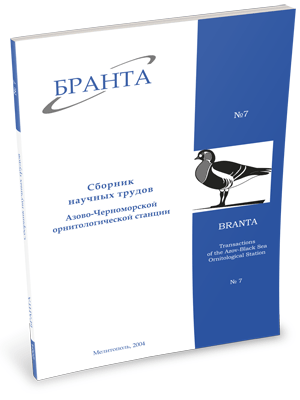
Transactions
of the Azov-Black Sea Ornithological Station



History and dynamics of colonial settlements of Ciconiidae in the Eastern Crimea under the influence of anthropogenic succession at the Eastern Sivash and near Sivash area.
Grinchenko A.B.
In a number of cases, some water bodies can considerably change their form under a human impact. Sivash is a typical model, especially its eastern part, where vast reed marshes have developed because of the water freshening, and indicators of this dynamic transformation are Ciconiidae (Ciconiiformes).
This phenomenon was induced by the construction of the North-Crimean canal (second half of 1960s). Its water was used for irrigation of agricultural lands, whereas drainage waters were removed into Sivash (a lagoon of the Sea of Azov).
Penetration of great quantity of fresh water in Sivash has led to fundamental transformation of habitats into anthropogenic succession. Instead of saline and hypersaline water bodies with very poor vegetation there have formed freshwater marshes with a plavni complex of plants. Then changes followed in composition of omithocomplexes, which are discussed in this paper by the example of development and dynamics of colonial breeding settlements of Ciconiidae (Ciconiiformes). The used material was collected during 1976-2003. For this period the plavni habitats step-by-step took five phases of anthropogenic succession. This process had influenced also on the quality of habitats that resulted in dynamic changes of colonial settlements of Ciconiiformes. The paper gives tables, which show the process of dynamic transformation of colonies over the mentioned period, and analyze the breeding of some species. There was also carried out analysis of species composition for colonies of different types and their inner interspecies relations. Variants to manage processes of anthropogenic succession and problems of protection of ornithocomplexes are considered.
Conclusion
1. For 20 years of development the anthropogenic succession of plavni habitats at the Sivash has reached its final phases.
2. Anthropogenic succession of Eastern Sivash is very sensible to fluctuations of the factor that caused it, i.e. to the volume of fresh water.
3. Main factor that limits colonial settlements of Eastern Sivash is a shortage of feeding areas.
4. Colonies react on worsening of forage conditions with dislocation of colonies toward remained feeding areas, with decrease of numbers of breeding birds, and losses in species composition in those extreme cases where colonies simply vanish.
5. Large and small species of herons are characterized by different resistance to difficult environment changes.
6. Reaction of colonies on difficult environment changes is tardy because the solution to shift breeding sites is taken by those species which are more resistant to unfavourable environments (large herons).
7. Colonial settlements at Eastern Sivash and in the near Sivash area are one largest in Ukraine and Europe, and undoubtedly must be under protection. The matter must be solved by means of establishing the Sivash National Park.
Read the paper in a PDF file